When researching emigration and immigration, researchers mainly focus on locating ships’ passenger lists to determine the name of the ship on which ancestors sailed and the dates of departure and arrival.
Here we will explore some often overlooked aspects of their journey, including their motivation for emigrating, making preparations, leaving home for the last time, arriving at the port of departure, the voyage and life on board the ship.

In the mid-nineteenth century, over 600,000 people emigrated to Victoria. Interest in the colonies and the perceived opportunities offered there contrasted with their circumstances which were often entrenched in hardship and a lack of hope. Many left their homeland to escape a life of poverty and unemployment, to follow family and friends already settled in the Colony, or for pure adventure.
In the 1850s the lure of the goldfields also attracted tens of thousands of people, hoping to find their fortune. Many others responded to government assistance schemes designed to populate the colonies and to provide a labour force. For the majority of emigrants, the motivation that underpinned emigration to Victoria was a sense of hope.
Leaving the place of origin was a major undertaking, however once the decision was made to emigrate, a series of processes were set in train. The first step would be to secure a suitable passage on a ship. Intending emigrants were informed about their options in various ways. Countless posters advertised voyages to Australia, promoting the advantages of specific ships and shipping lines.
Unassisted emigrants funded the cost of their own voyages. Information on unassisted immigrant’s passenger lists (1852-1923) can be found on our Victorian immigration and emigration research guide.

Other emigrants applied for one of the assisted emigrant schemes, where government or philanthropic organisations financed all or part of their passage. These schemes helped to populate the colony and provide much needed labour. Information on assisted immigrant’s passenger lists (1839-1871) can be found on our Victorian immigration and emigration research guide.
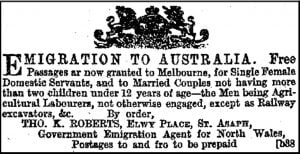
Once a passage was organised, intending emigrants would begin their preparations. Poorer emigrants with very few possessions, had little to prepare. For others, property ownership had to be settled and assets liquidated before leaving the country.
Emigration Agents, located at seaports and in towns throughout the country, provided a range of services for emigrants including: organising the passage, advice regarding luggage and provisions and arranging the transportation of luggage to the port of departure and onto the ship.

Preparations would also include organising ‘Outfits’ for the voyage and purchasing supplies to take for their life in Victoria.
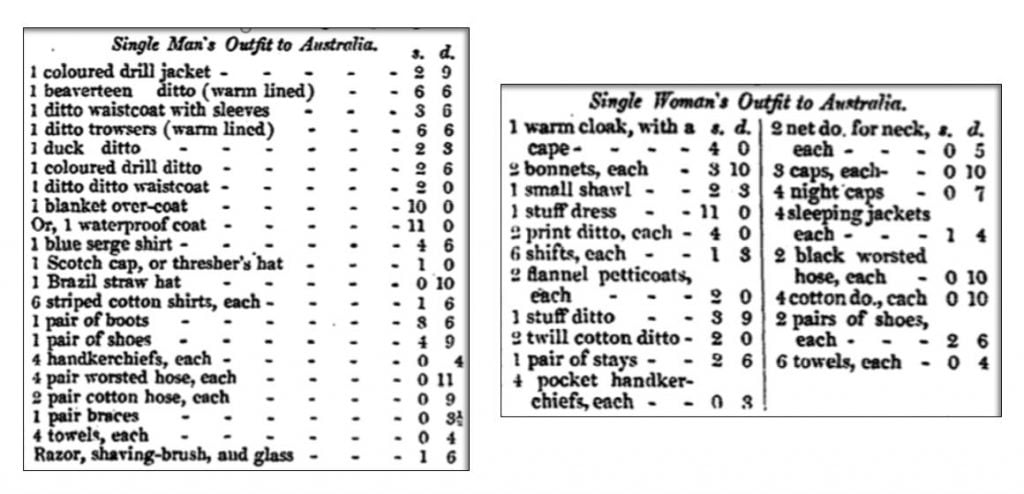
Published ‘Emigrant Guides’ gave emigrants detailed advice about preparing for their journey and how to adjust to life onboard the ship. They covered everything from what supplies and clothing to pack, hints for entertainment and pastimes and information on shipboard life including etiquette and routines.

On first going on board the ship, the emigrant should be very calm and self-possessed, and above all things, keep himself out of the way of everybody and everything; by no means an easy matter for a landsman. He should be very reserved in his intercourse with his fellow-passengers; it is very difficult to judge of people at first, and it is by far the best way to keep a certain distant deportment.
Taken from: Remarks for the use of emigrants.
Many emigrant guides have been digitised and can be found through the State Library Victoria’s catalogue and Trove. Two guides worth exploring are – Emigrant’s guide to Australia: with a memoir of Mrs. Chisholm and Outward bound; or, Hints to emigrant families.
Once a passage was secured and preparations made, the emigrants would say goodbye to family and friends, perhaps having last conversations expressing their thoughts of anticipation, sadness, expectations, anxiety and excitement. These emotions would be heightened for many who had a very limited world view. As their journey began, they would take a last look at their homes and homelands. They would then make their way, travelling by coach, by train or by foot, in all weathers, to one of the British ports of embarkation.
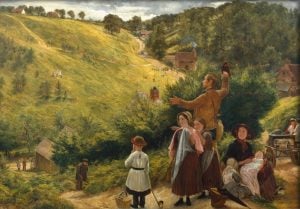
At the port of departure some passengers may be able to afford private accommodation, while others would gather and sleep at the dock, sometimes for days before departure.
For the government assisted emigrants, the Emigration Depot was the last gathering point before their voyage and they would lodge there until departure.

Those with means could make their way from their shore accommodation onto the ship at the last moment and make a grand entrance. Before it was regulated, many passengers would rush on board in a first come – first serve manner.

Several classes of accommodation were available, including Saloon, Cabin, Intermediate and Steerage. First class passengers had cabins on the poop deck and intermediate cabins were situated in the rear of the main deck. Steerage passengers were housed between decks in cramped, noisy, damp conditions. Single women were housed in one area, single men often had hammocks towards the back of the ship and married couples and families were accommodated in-between. In the Victorian era, the class system was clearly defined and adhered to onboard the ship as it was on land.

Steerage passengers were often divided into groups or messes of up to ten people. A Mess Captain was appointed who would gather and distribute weekly rations and keep order in the mess. The roles of constables, cook’s assistant and matron may be assigned as was a teacher or religious instructor, if one hadn’t already been appointed.
Shipboard routine would begin and continue for the duration of the voyage.
Each morning passengers were required to rise early and stow their bedding. Because of the risk of disease, and the need to keep all areas dry, they were required to clean their quarters thoroughly. Male passengers were regularly called on to clean the ship’s decks, to keep watch and assist with other shipboard duties.
Meals were regulated at different times throughout the day. The diet for steerage passengers was very plain. Second class passengers fared better, with greater quantities of food whilst first-class passengers received fresh produce and preserved goods and often dined with the ship’s captain.
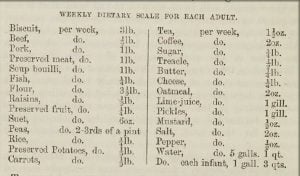
The journey to Australia was long and often monotonous. Passengers were encouraged to get plenty of exercise and spend as much time as possible on deck. Music and dancing were promoted as was `every harmless means of combining exercise and amusement’ (Parliamentary paper; 1852). Other shipboard activities included craftwork, storytelling, reading aloud, quoits, cricket and boxing, however inclement weather meant that passengers were often forced to spend much of their time below deck.
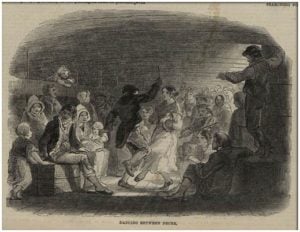
Many passengers kept diaries that documented their daily experiences. A number of shipboard diaries and journals can be found in the State Library Victoria and through Trove. Passengers also produced shipboard newspapers which reported on the weather, social events, births and deaths, lotteries, amusing incidents and items for sale.

The Marco Polo chronicle. (1854, July 29).
Voyages from the UK to Victoria in the mid-nineteenth century could last up to 3 months or more. Ships would sail from west to east through the Southern Ocean and were mostly dependent on the ‘Roaring Forties’, the strong winds encountered on the ‘Great Circle’ route.
The State Library Victoria holds thousands of images of ships, including many of emigrant ships. Images can be found through the library catalogue.
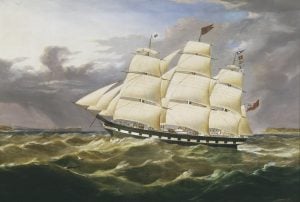
The great majority of emigrants left their homeland with a sense of hope. They endured the voyage with all that nineteenth century ship travel presented, including excitement, fear, routine, danger and tragedy. On arrival at Victoria, one hopes that they carried that same sense of hope as they began their next journey into their lives in the colony.

To the land of Hope! video resource list.
Further information
- Information on researching Victorian assisted and unassisted passenger lists, outward journeys and crew lists can be found on our Victorian immigration and emigration research guide.
- Information on researching ships journeys, including images of ships, can be found on our Ships and shipping research guide.

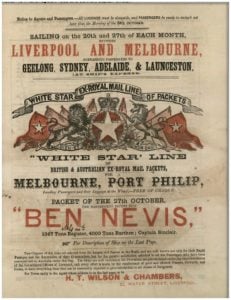

Great informative overview, thanks.
Dear T Carter. Thank you for your kind words. Emigration and immigration are huge subject areas with many components and associated records. Hopefully, the overview can introduce some aspects of the subject areas that researchers may not readily think of and promote further research. Thanks again. Grant. State Library Victoria
Hi Grant,
thanks so much for sharing this information. It is exactly what I have been looking for. I am really interested in those overlooked aspects of the journey. I could find lots of information about figures of emigration, but hardly anything about the processes involved.
Cheers
John
Great information Grant
I had discovered family who were bounty immigrants but listed as intermediate and you have told me what that meant.
Thank you
Marty
Thanks Grant. This will greatly help put some flesh around my Scottish Ancestors from Paisley. The mother, Mary Ryburn (nee McLauchlan) arrived in Port Phillip with son Duncan on the “Almora” December 29, 1857 and were disposed to husband Robert Ryburn. According to his August 10, 1910 Victorian Death Certificate informed by his son John Reaburn, Robert had been a ‘resident’ for 55 1/2 years, suggesting he arrived in Melbourne early-mid 1854. My brick wall is when and on what ship did he arrive? I’ve searched every online passenger list I can find over countless hours. Any advice or help valued. Peter 🙂
Thank you for your inquiry Peter. I have lodged it through our online Ask a Librarian service, and one of our librarians will get in touch soon.
Kind regards,
Carmen
My mother migrated 1922 with her son. She told me a lot but I don’t know how she obtained employment on a farm nor was she sponsored perhaps by the Salvation Army. She was met on arrival and given the sum of five pounds which was a lot. I asked why she came and was told the posters everywhere said “come to sunny Australia “. I could recount many stories she told me. Her name was Hannah Singh and her son Gerald Singh. She was widowed her husband and son died from tuberculosis. I can only imagine the despair which caused her to take the step and the shock of being responsible for both of them alone in a strange country.
Thank you. My great-great-grandfather was an assisted emigrant (a Cornish miner) who left, with wife and baby daughter, from Liverpool on the ship North. You have provided me with many of the small details that an overall picture of assisted emigration does not include. He was a ‘nominated’ emigrant to Adelaide. Do you have any idea what ‘nominated’ means?
Thank you for your query Carolyn. The term `nominated’ emigrant, was mainly used in South Australia. It referred to the migrants who had been nominated or selected for assisted passage to Australia. In many cases the term Assisted immigrant was used instead. Kind regards Ann